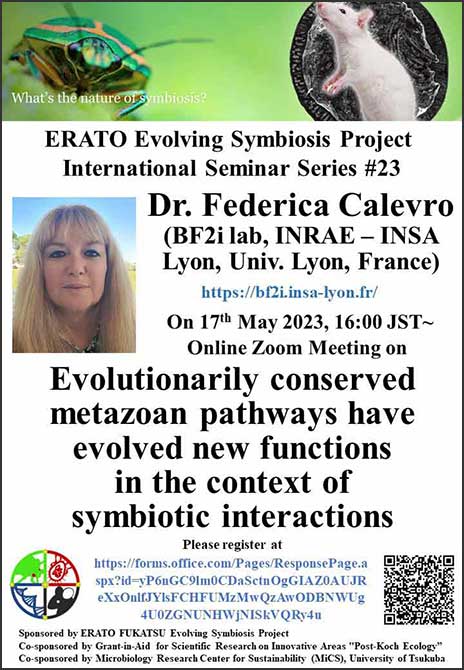ERATO Evolving Symbiosis Project International Seminar Series #23
Dr. Federica Calevro (BF2i lab, INRAE – INSA Lyon, University of Lyon, France)
“Evolutionarily conserved metazoan pathways have evolved new functions in the context of symbiotic interactions”

Abstract: The association between the pea aphid and its primary endosymbiont, Buchnera aphidicola, is one of the best studied insect symbioses at the metabolic and evolutionary levels. Nevertheless, the molecular and cellular determinants that regulate the dialogue between the insect host and its symbiotic bacteria are only beginning to be elucidated. Coupling physiology, immunohistochemistry and RNA-seq approaches with machine learning-based gene regulatory network inference, my team discovered that evolutionarily conserved metazoan pathways have evolved and/or diversified to regulate this symbiosis. In this talk, I will focus on three pathways (the apoptosis, UPR and CLEAR pathways) and their interaction with the endomembrane system. I will show how they allow the bacteriocytes (the symbiont-containing cells) to adapt to the presence in their cytoplasm of millions of symbiotic bacteria throughout insect development and to eliminate them after the onset of the reproductive peak, or to regulate their numbers in response to nutritional stresses. I will then take advantage of the availability of several aphid genomes to present the evolutionary history of some of the above pathways. The analysis of the mono-symbiotic association between B. aphidicola and the pea aphid will be used as a starting point for comparative studies on multi-partner symbiotic associations.
ERATO Evolving Symbiosis Project International Seminar Series #23
Sponsored by ERATO FUKATSU Evolving Symbiosis Project
https://www.jst.go.jp/erato/fukatsu/english/
Co-sponsored by Grant-in-Aid for Scientific Research on Innovative Areas "Post-Koch Ecology”
https://postkoch.jp/about/
Co-sponsored by Microbiology Research Center for Sustainability (MiCS), University of Tsukuba
https://www.mics.tsukuba.ac.jp/en


